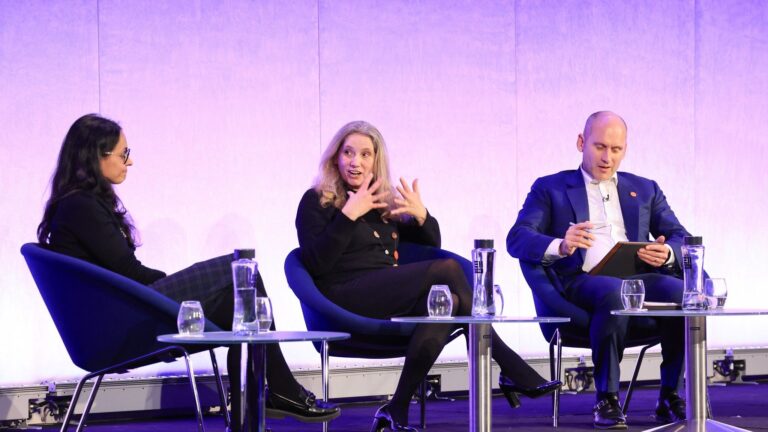
Rebranding, in 2022, as International Energy Week (IEW), the conference has shifted its narrative to reflect a sector in transition – no longer centred on hydrocarbons, but expanding the dialogue to renewables, clean technologies, and climate science.
This year’s event was a turning point. Not just in tone – but in substance.
A climate science reality check
One standout session, chaired by Nick Wayth, Chief Executive of the Energy Institute, featured two of the world’s leading climate scientists:
- Professor Emily Shuckburgh OBE, Director of Cambridge Zero, and
- Dr. Radhika Khosla, Associate Professor at Oxford University and Programme Leader at the ZERO Institute.
With both immersed in climate study they were invited to share their experiences of real-world impacts. Their message? The climate crisis is not a looming threat. It’s here and now – and escalating at an alarming and non-linear pace.
Shuckburgh laid out the stark reality: climate impacts are now accelerating exponentially. “The changes we’ve warned about for three decades are unfolding far faster than expected,” she said. “Extreme weather events – heat, wildfires and flooding – are no longer academic theories, they’re daily news. And they are just the start.”
Tipping points and non-linear risk
Perhaps the most unsettling insight was the growing risk of passing climate tipping points. These are irreversible thresholds, such as the collapse of the Greenland ice sheet or the shutdown of ocean circulation, beyond which dramatic environmental shifts are locked in.
“These are not hypothetical,” Shuckburgh warned. “They’ve happened in Earth’s past and, like species extinction, cannot be undone.”
The message was clear: the consequences of inaction are growing and not gradually, but exponentially.
Extreme heat: The overlooked crisis
While many associate climate change with floods, wildfires or droughts, Dr. Khosla highlighted something even more deadly yet frequently overlooked: extreme heat.
“Heat kills more people than any other extreme weather event,” she explained. “It’s increasing in frequency, duration and intensity.”
‘Blind spot’ seems an entirely appropriate description when you consider that terms like cooling, heat, or thermal are completely absent from the UN Sustainable Development Goals.
Dr. Khosla’s research on the rise of extreme heat shows, unsurprisingly perhaps, that the greatest absolute increase in heat days will hit African nations. However, the largest relative change will occur in European countries, with the UK ranking second. It is not just a hot country issue – even countries used to cooler climates are dangerously unprepared.
The cooling paradox
Here’s the conundrum: as heat rises, so does demand for air conditioning. But air conditioning units are powered by fossil-fuelled grids, energy intensive, and use refrigerants with high global warming potential. The result? A feedback loop of increasing energy demand, rising emissions and rising temperatures.
90% of US homes have air con. In India it’s 18% and 5% in Nigeria. Projected populations of India and Nigeria alone will mean 2 billion people needing cooling by 2050.
If air-con becomes the solution of choice, by the end of the century, global energy demand for cooling will exceed total energy demand today.
But there are alternative routes:
- Passive cooling through smart building design and urban planning.
- Efficiency standards reducing energy demand from next-gen cooling systems.
- Faster phase-out of harmful refrigerants.
These steps could cut cooling-related emissions by two-thirds. The remaining third? Through decarbonised electricity.
Global equity: Clean energy must be the default
Perhaps the most powerful moment of the session came when the conversation turned to developing nations who argue for their right to use gas reserves to fuel development. Shuckburgh’s response was both compassionate and pragmatic:
“Yes, these countries need energy. But locking into fossil fuels isn’t the path to future prosperity – it’s a dead end.”
Instead, she and Khosla championed clean, context-sensitive energy systems as both a moral and economic imperative. But solutions must be determined by communities – not dictated to them.
As Khosla put it: “To embed a just energy transition, we must meet people where they are – food, jobs, safety. Making changes towards a just energy system delivers these core benefits.”
AI: A new tool in the climate arsenal
Asked what developments in climate science could help us better understand and respond, Shuckburgh highlighted AI.
“We’re using AI to improve our ability to model the climate and its impacts, and it is genuinely transformative,” she said. “Agencies like the Met Office are already using it to outperform traditional forecasts. Energy firms are applying similar tools to predict solar yield, optimise wind farm operations, and anticipate grid fluctuations.
“AI also enables us to integrate diverse data sources – weather, demographics, health vulnerabilities – to better predict things like lethal heatwaves.”
But AI has its own energy footprint – responsible use is key.
It’s not just about energy. It’s about everything.
This wasn’t just a climate session – it was a reframing of what energy means right now.
Where IEW might previously have showcased exploration techniques and fossil financing, it now wrestles with questions of human health, equity, and global energy. This isn’t mission drift – it’s mission evolution.
As Shuckburgh was awarded Honorary Fellowship of the Energy Institute, the message was clear: the mic is being passed from the old guard to science, data, and innovation – precisely where energy leaders need to be looking.
With clean energy no longer an adjacent sector but central to a just transition, International Energy Week has made its pivot. Now the question is: how do we?
Image credit: The Energy Institute/International Energy Week
